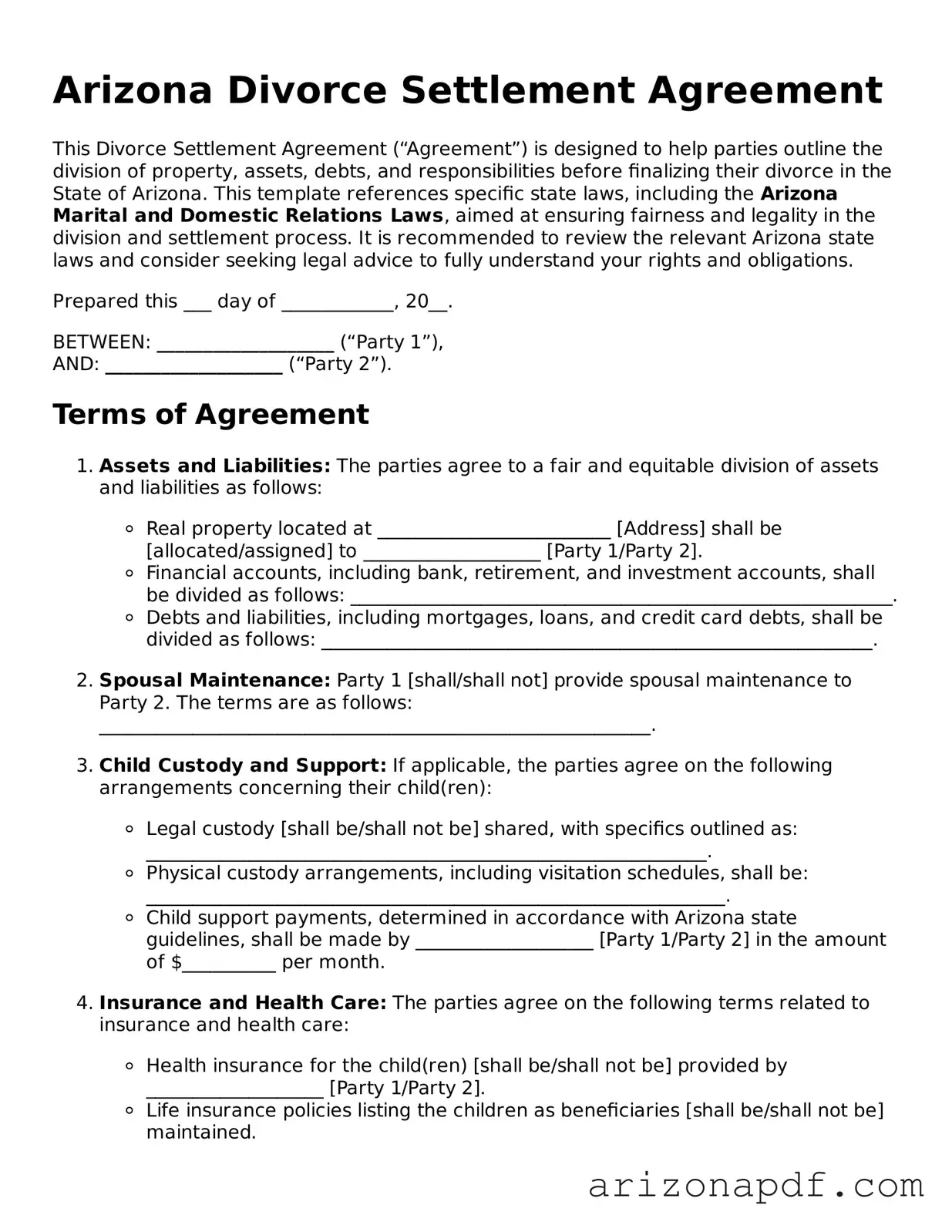What is an Arizona Divorce Settlement Agreement?
In Arizona, a Divorce Settlement Agreement is a legally binding document where divorcing parties outline the terms of their separation. These terms often include division of marital assets and debts, child custody and visitation schedules if applicable, spousal and child support agreements, and any other agreements pertinent to the dissolution of marriage. This document, once signed by both parties and approved by the court, becomes part of the final divorce decree.
How do you create a Divorce Settlement Agreement in Arizona?
Creating a Divorce Settlement Agreement in Arizona typically involves negotiation between the divorcing parties, often with the help of their attorneys. Once an agreement is reached on all pertinent issues, the terms are drafted into a formal document. Both parties must review this document carefully, make any necessary revisions, and then sign it. To be enforceable, the agreement must then be filed with the court and approved by a judge as part of the divorce proceeding.
Is a lawyer required to file a Divorce Settlement Agreement in Arizona?
While it is not mandatory to hire a lawyer to file a Divorce Settlement Agreement in Arizona, legal guidance is strongly recommended. Divorce law can be complex, and a lawyer can help ensure that the agreement adequately protects one's rights and interests. An attorney can also help mediate and negotiate terms, draft the agreement to meet legal standards, and represent the party during court proceedings if necessary.
What happens if we cannot agree on the terms of the Divorce Settlement Agreement?
If divorcing parties cannot agree on the terms of the Divorce Settlement Agreement, they may need to attend mediation, where a neutral third party helps facilitate negotiation. If mediation fails, the divorce case may go to trial, where a judge will make decisions regarding the disputed issues. Going to trial often results in more stress and higher costs for both parties, so it is typically seen as a last resort.
Can the terms of a Divorce Settlement Agreement be modified after it is signed in Arizona?
Yes, the terms of a Divorce Settlement Agreement can be modified after it is signed, but only under certain conditions. Modifications are usually considered if there has been a significant change in circumstances for one or both parties. For example, if one party experiences a substantial change in income, the child custody arrangement might need reassessment. To modify the agreement, the party seeking the change must file a petition with the court, and both parties must agree to the amendments or leave the decision to a judge.
How is property divided in an Arizona Divorce Settlement Agreement?
In Arizona, which is a community property state, all marital property is generally divided equally between the spouses. Marital property includes all assets and debts acquired during the marriage, except for gifts and inheritances received by one spouse. Each spouse typically retains their own separate property, which includes assets and debts they had before the marriage or received as a gift or inheritance during the marriage. The specific division of property is detailed in the Divorce Settlement Agreement, and the division must be fair and equitable to both parties.
What should be included in a comprehensive Divorce Settlement Agreement in Arizona?
A comprehensive Divorce Settlement Agreement in Arizona should clearly outline the division of all marital assets and debts, detail the child custody and visitation schedule if applicable, specify the amount and duration of any spousal and child support, and cover any other agreements related to the marriage dissolution. It can also include terms about the allocation of health insurance benefits, retirement account divisions, tax considerations, and any other pertinent details. The aim is to cover all bases to prevent future disputes and ensure the agreement adheres to Arizona law.
